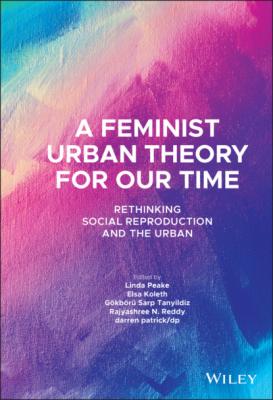A Feminist Urban Theory for Our Time. Группа авторов
Читать онлайн.| Название | A Feminist Urban Theory for Our Time |
|---|---|
| Автор произведения | Группа авторов |
| Жанр | Социология |
| Серия | |
| Издательство | Социология |
| Год выпуска | 0 |
| isbn | 9781119789178 |
70 Lawson, V. (1995). The politics of difference: Examining the quantitative/qualitative dualism in post-structuralist feminist research. The Professional Geographer 47 (4): 449–457.
71 Lefebvre, H. (2003 [1970]). The Urban Revolution (trans. R. Bononno). Minneapolis, MN: University of Minnesosta Press.
72 Leiper, C. (2017). ‘Re-wilding’ the body in the Anthropocene and out ecological lives’ work. Environment and Planning D: Society and Space (14 November). www.societyandspace.org/articles/re-wilding-the-body-in-the-anthropocene-and-our-ecological-lives-work (accessed 8 April 2020).
73 Linebaugh, P. (2008). The Magna Carta Manifesto: Liberties and Commons for All. Berkeley, CA: University of California Press.
74 Lofland, L. (1975). The ‘thereness’of women: A selective review of urban sociology. In: Another Voice: Feminist Perspectives on Social Life and Social Science (eds. M. Millman and R.M. Kanter), 144–170. New York: Anchor Press.
75 Mackenzie, S. (1980). Women and the Reproduction of Labour Power in the Industrial City. Falmer, Brighton: University of Sussex (Urban and Regional Studies). http://www.worldcat.org/oclc/609593273
76 Maldonado-Torres, N. (2007). On the coloniality of being: Contributions to the development of a concept. Cultural Studies 21 (2–3): 240–270.
77 Markusen, A. (1980). City spatial structure, women’s household work and national urban policy. Signs: Journal of Women in Culture and Society 5 (3): S22–S44.
78 Martin, R. (2002). The Financialization of Daily Life. Philadelphia, PA: Temple University Press.
79 Marx, K. (1993 [1885]). Capital: Volume II (trans. D. Fernbach). Middlesex: Penguin Classics Ltd.
80 Mbembe, A. (2004). Aesthetics of superfluity. Public Culture 16 (3): 373–405.
81 McFarlane, C. (2010). The comparative city: Knowledge, learning, urbanism. International Journal of Urban and Regional Research 34 (4): 725–742.
82 McKeithen, W. and Naslund, S. (2017). Worms and workers: Placing the more-than-human and the biological in social reproduction. Environment and Planning D: Society and Space (14 November). www.societyandspace.org/articles/worms-and-workers-placing-the-more-than-human-and-the-biological-in-social-reproduction (accessed 8 April 2020).
83 Meehan, K. and Strauss, K. eds. (2015). Precarious Worlds: Contested Geographies of Social Reproduction. Athens, GA: The University of Georgia Press.
84 Miraftab, F. (2016). Global Heartland: Displaced Labour, Transnational Lives, and Local Placemaking. Bloomington, IN: Indiana University Press.
85 Mitchell, K., Marston, S.A., and Katz, C. eds. (2004). Life’s Work: Geographies of Social Reproduction. Malden, MA: Blackwell Publishing.
86 Mohanty, C. (1988). Under Western eyes: Feminist scholarship and colonial discourses. Feminist Review 30 (1): 61–88.
87 Moyser, M. and Burlock, A. (2018). Time use: Total work burden, unpaid work, and leisure. Women in Canada: A gender-based statistical report. Statistics Canada. www150.statcan.gc.ca/n1/en/pub/89-503-x/2015001/article/54931-eng.pdf?st=30YnK5X5 (accessed 9 April 2020).
88 Nagar, R. (2019). Hungry Translations: Relearning the World Through Radical Vulnerbility. Champaign, IL: University of Illinois Press.
89 Nagar, R. (2002). Footloose researchers, ‘traveling’ theories, and the politics of transnational feminist praxis. Gender, Place & Culture 9 (2): 179–186.
90 Nagar, R. (2008). Languages of collaboration. In: Feminisms in Geography: Rethinking Space, Place, and Knowledges (eds. P. Moss and K.F. Al-Hindi), 120–129. Plymouth: Rowman & Littlefield.
91 Nijman, J. (2007). Introduction: Comparative urbanism. Urban Geography 28 (1): 1–6.
92 Norton, J. and Katz, C. (2017). Social reproduction. In: The International Encyclopedia of Geography (eds. D. Richardson, N. Castree, M.F. Goodchild et al.), 1–11. Oxford: Wiley & Sons, Ltd.
93 Noxolo, P. (2017). Introduction: Decolonising geographical knowledge. Area 49 (3): 317–319.
94 Office for National Statistics (2016). Women shoulder the responsibility of ‘unpaid work’. Office for National Statistics. www.ons.gov.uk/employmentandlabourmarket/peopleinwork/earningsandworkinghours/articles/womenshouldertheresponsibilityofunpaidwork/2016-11-10 (accessed9 April 2020).
95 Parreñas, R.S. (2012). The reproductive labour of migrant workers. Global Networks 12 (2): 269–275.
96 Peake, L. (2015). The Suzanne Mackenzie Memorial Lecture: Rethinking the politics of feminist knowledge production in Anglo‐American geography. The Canadian Geographer/Le Géographe Canadien 59 (3): 257–266.
97 Peake, L. (2016). On feminism and feminist allies in urban geography. Urban Geography 37 (6): 830–838.
98 Peake, L. (2017). Feminism and the urban. In: A Research Agenda for Cities: Elgar Research Agendas (ed. J. Short), 82–97. Cheltenham: Edward Elgar.
99 Peake, L. (2020). Gender and the city. In: International Encyclopaedia of Human Geography (ed. A. Kobayashi), Second Edition, Vol. 5, 281–292. London: Elsevier.
100 Peake, L., Patrick, M., Reddy, R. et al. (2018). Placing planetary urbanization in other fields of vision. Environment and Planning D: Society and Space 36 (3): 374–386.
101 Pearson, R. and Elson, D. (2015). Transcending the impact of the financial crisis in the United Kingdom: Towards plan F – a feminist economic strategy. Feminist Review 109 (1): 8–30.
102 Piketty, T. (2015). Capital, inequality and justice: Reflections on capital in the twenty-first century. Basic Income Studies 10 (1): 141–156.
103 Pratt, G. (2018). One hand clapping: Notes towards a methodology for debating planetary urbanization. Environment and Planning D: Society and Space 36 (3): 563–569.
104 Puar, J.K. ed. (2012). Precarity talk: A virtual roundtable with Lauren Berlant, Judith Butler, Bojana Cvejić, Isabell Lorey, Jasbir Puar, and Ana Vujanović. TDR: The Drama Review 56 (4): 163–177. https://muse.jhu.edu/article/491900
105 Rendell, J., Penner, B., and Borden, I. eds. (2000). Gender Space Architecture: An Interdisciplinary Introduction. London: Routledge.
106 Robinson, J. (2011). Cities in a world of cities: The comparative gesture. International Journal of Urban and Regional Research 35 (1): 1–23.
107 Roy, A. (2009). The 21st-century metropolis: New geographies of theory. Regional Studies: The Futures of the City Region 43 (6): 819–830.
108 Roy, A. (2016a). Who’s afraid of postcolonial theory? International Journal of Urban and Regional Research 40 (1): 200–209.
109 Roy, A. (2016b). What is urban about critical urban theory? Urban Geography 37 (6): 810–823.
110 Ruddick, S. (2015). Situating the Anthropocene: Planetary urbanization and the anthropological machine. Urban Geography 36 (8): 1113–1130.
111 Ruddick, S. (2017). Rethinking the subject, reimagining worlds. Dialogues in Human Geography 7 (2): 119–139.
112 Ruddick, S., Peake, L., Tanyildiz, G.S. et al. (2018). Planetary urbanization: An urban theory for our time? Environment and Planning D: Society and Space 36 (3): 387–404.
113 Schindler,
